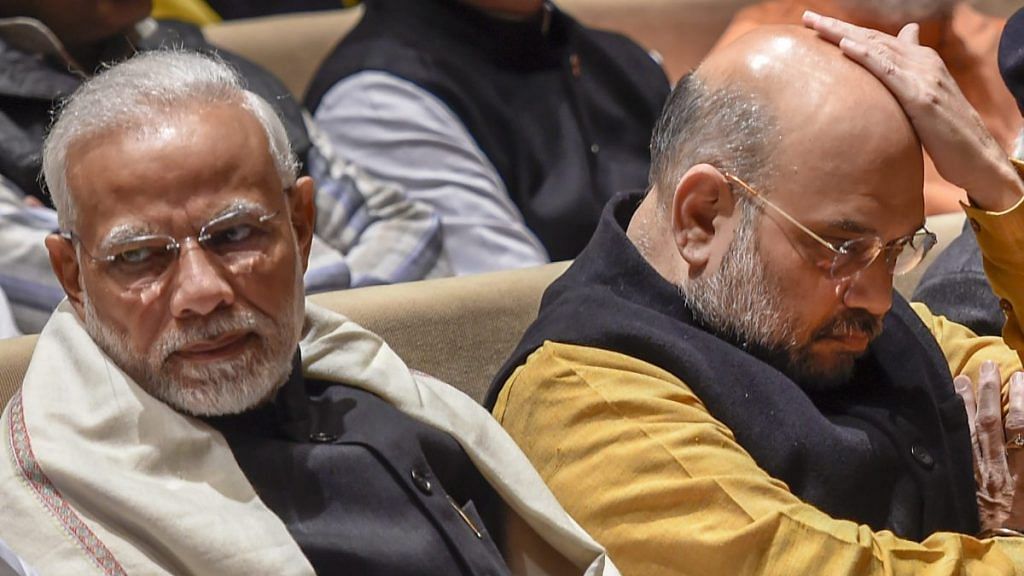Regional parties will guard their turf assiduously by not yielding their space to either of the two national parties.
The victory of the Congress in Madhya Pradesh, Rajasthan and Chhattisgarh has added a spring in its step. But the Congress revival in Lok Sabha looks like a distant dream. Whoever wears the crown – the BJP or the Congress – the regional parties could emerge as the kingmakers in 2019.
The immediate question haunting the BJP is the electoral arithmetic in the 2019 Lok Sabha elections. With 272 seats and several big states under its command till last week, the BJP was only concerned about consolidating its position further and going to the voters with 300+ seats slogan (ab ki baar teensau paar).
Post 2018 assembly elections, the BJP should be worried more about retaining the numbers it got in 2014 and avoiding a reversal. For the Congress, it is three steps forward and two steps backward, if you take the loss in Mizoram and Telangana into account.
With both the BJP and the Congress likely to struggle to cross the magic figure of halfway mark in Lok Sabha in 2019, the regional parties are the ones who seem to be sharpening their swords before the kill.
Also read: Why BJP is staring at a loss of nearly 100 seats from 2014 tally
The electoral math
A quick look at the spread of numbers would suggest a different view of the 2019 Lok Sabha. Out of the 543 seats (412 General, 84 SC and 47 ST seats) in 29 states and seven Union Territories (UTs), the BJP and its allies are ruling in 17 states, which account for 254 seats.
The Congress is in command in four states, which together have 78 Lok Sabha seats. It is sharing power with JD(S) in Karnataka, a state that accounts for 28 Lok Sabha seats. The non-Congress, non-BJP parties are in power in six states, which have 164 Lok Sabha seats. Jammu and Kashmir is under Governor’s rule.
In the changed circumstances after the recent assembly election results, Mayawati’s Bahujan Samaj Party made a U-turn and decided to support the Congress in Madhya Pradesh. But closer to 2019, the BSP and the Samajwadi Party would strategise differently. The two of them came together in early 2018 to deal a humiliating blow to the BJP candidate in Gorakhpur, a seat vacated by Uttar Pradesh chief minister Yogi Adityanath.
Politics of coalition
Coalition politics is now a reality. In 1967, the Congress won majority in Lok Sabha but lost in many states. Soon after that, the infamous split took place in 1969. Subsequently, the party had to change its policy and accept the reality of having to depend on regional parties. The Vajpayee government reinforced this aspect of Indian politics and completed a successful term with nearly two dozen parties as alliance partners in the NDA government.
The UPA, a coalition led by the Congress, followed the same pattern from 2004 to 2014. The trend was broken in 2014 when Narendra Modi and BJP registered an impressive victory with 282 seats and did not require any alliance partners to run the government. Nevertheless, the NDA remained as one unit but all does not seem to be well with the alliance partners of the BJP.
Also read: Can the Shiv Sena be in the opposition and government at the same time?
The Shiv Sena has more than once expressed its resolve to jettison the BJP in 2019, while the Shiromani Akali Dal (SAD) in Punjab is stronger than the BJP. The AIADMK is now a close ally of the BJP but some of its leaders doubt the advantage the BJP could deliver in Tamil Nadu where the party has no support base.
The BJP won 22 seats in Bihar, reducing the Janata Dal (United) to a mere two seats in 2014. The two are partners now, but it is doubtful if they can successfully transfer their votes to each other for a landslide victory. Besides, the non-Congress coalition too is gaining momentum in Bihar, adding strength to the possibility of a mini-mahagathbandhan.
The Samajwadi Party and the Bahujan Samaj Party in Uttar Pradesh would prefer to mop up maximum seats between them and may not oblige the Congress. The same could be the situation in West Bengal where Mamata Banerjee’s TMC would prefer to go it alone resulting in a four-cornered contest with the Congress, the Left and the BJP.
Also read: Why political parties are scared of Lalu Prasad Yadav
Guarding regional turf
In all, the regional parties will guard their turf assiduously by not yielding their space to either of the two national parties in these 164 Lok Sabha seats. The strike rate of the BJP and the Congress in these states is abysmally poor. There are nearly 122 Lok Sabha constituencies which the BJP has never won since its formation. Most of these seats fall under this grouping of 164 seats.
In the event of the BJP falling short of the magic number, it will have to depend on the allies. An aggressive posture has not helped the BJP in keeping its friends any closer. The party will have to be more accommodative in the coming months to win friends and influence voters. The Congress can gloat over its sudden victory but will have to shine in reflected glory post 2019 elections because on its own, it stands no chance to reach the three digit mark in Lok Sabha.
Regional parties may turn out to be the kingmakers.
The author is former editor of ‘Organiser’.
